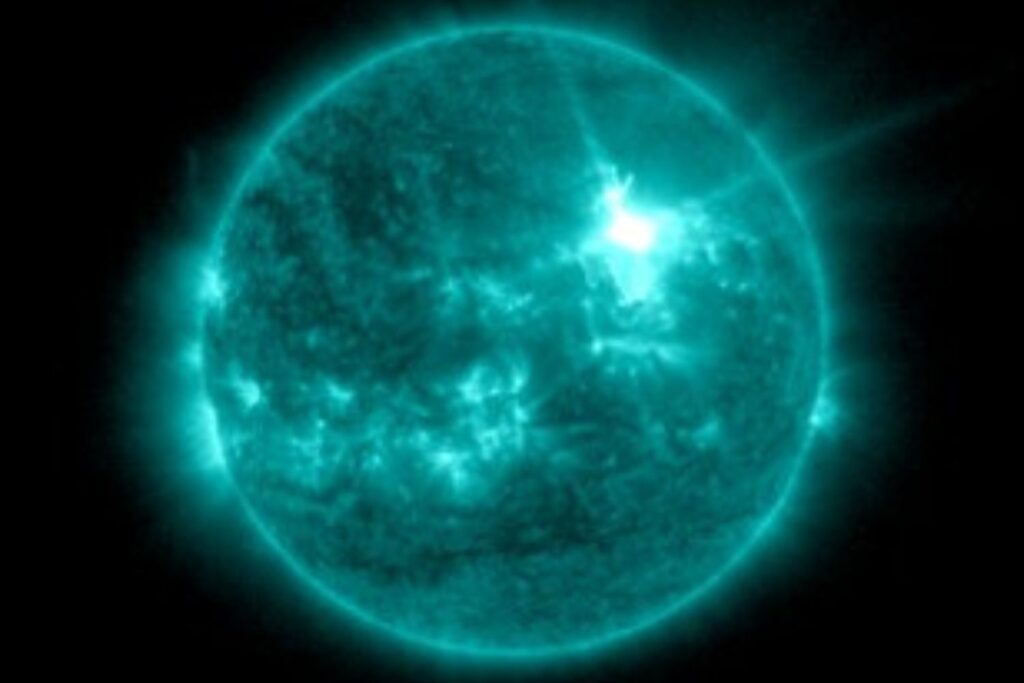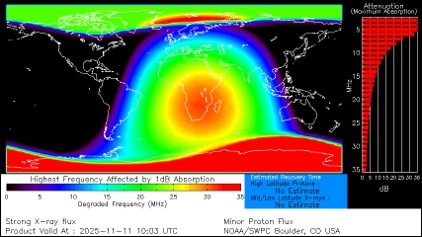
This image of the sun shows the X-class solar flare on Tuesday 11 November. Picture: SANSA
The biggest geomagnetic storm of the year to date is currently in progress, causing possible disruptions to technological systems such as Global Navigation Satellite Systems (GNSS) that affect aviation, maritime and drone industries.
Other systems affected include communication, electrical power grids and electronic infrastructure.
Geomagnetic storms
Geomagnetic storms are caused by coronal mass ejections (CMEs) which are vast clouds of charged particles released during a solar explosion. When these particles reach Earth and interact with its magnetic field, they can trigger geomagnetic storms.
These storms are responsible for producing the spectacular auroras visible near the North and South poles.
Active Sun
According to the South African National Space Agency (Sansa), the Sun has been active over past three days with three X-class (strong) solar flares observed.
Sansa said geomagnetic storm levels range from from G1 (minor), G2 (moderate), G3 (strong), G4 (severe) and G5 (extreme).
“X-class or strong solar flares were observed on Sunday 9 November, Monday 10 November and Tuesday 11 November. All three solar flares were accompanied by coronal mass ejections (CMEs), which are clouds of charged particles hurled into space.
“The two CMEs that were triggered by the solar flares on Sunday and Monday combined and impacted Earth from early this morning at about 01:30, causing G4 or Severe geomagnetic storm conditions,” Sansa said.

NOW READ: WATCH: NASA scrubs Artemis I launch to moon after fuel leaks
Solar flare
A solar flare is a sudden burst of light from the Sun and takes about 8 minutes to reach Earth. The impact causes high frequency radio blackouts in daytime regions.
“The coronal mass ejection associated with Tuesday’s X-class solar flare is expected to hit Earth later tonight or early tomorrow morning, resulting in continued geomagnetic activity.
“The SANSA Space Weather Centre expects storm conditions to reach between G1 and G4 levels, which will affect Earth and our technological systems up until 14 November 2025. Aurora is rarely seen in South Africa due to our distance from the polar region. However, photographers might want to keep their cameras handy. A dark, cloudless night is needed to observe aurora,” Sansa said.
Monitoring
SANSA said it is monitoring the impact of the storm as it approaches Earth through a network of ground-based instruments spanning the African continent, the Southern Ocean, and Antarctica.
“SANSA works with space weather centres across the globe to monitor these storms. There is no way to prevent geomagnetic storms from impacting Earth; however, industries working with these technological systems can implement mitigating steps to minimise the impact,” it said.
ALSO READ: Huawei Cloud and Cell C Business sign MoU to accelerate digital transformation in SA





